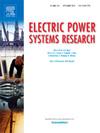Optimal parameter setting of wind farm for frequency regulation based on evaluation of available kinetic energy
IF 3.3
3区 工程技术
Q2 ENGINEERING, ELECTRICAL & ELECTRONIC
引用次数: 0
Abstract
When a wind farm (WF) provides frequency support for the power grid, the frequency regulation parameters of wind turbine generators (WTGs) are normally set by the control of the rotor-side converter and generally decoupled from the time-varying available rotor kinetic energy (RKE) in WTGs. Therefore, it may lead to a mismatch between the frequency regulation parameters and the frequency regulation ability of a WTG. The paper proposed an optimal WF frequency regulation parameter setting method, considering the available RKE evaluation and establishing the coupling relationship between frequency regulation parameters and available RKE. Firstly, by analyzing the spatiotemporal differences in wind speed within a WF using copula functions and the improved LSH![]() CD (Latin hypercube sampling-Cholesky decomposition) method, a forecasting scenario-based evaluation method of the WF available RKE for a future time is proposed. Secondly, to improve the system frequency dynamic response under power disturbance, a functional optimization model for WF frequency regulation parameters is constructed and offline solved with numerical method to realize the adaptive frequency regulation parameters set according to the time-varying available RKE of WF. Then the frequency regulation parameters of the WTGs within a WF are set according to the energy-weight ratio. Finally, a case study is conducted to verify the proposed available RKE evaluation and the effectiveness of the optimal frequency regulation parameter setting method. The results show that the energy evaluation method can effectively reduce evaluation error and the optimal frequency regulation parameter can improve the system frequency dynamic response, and prevent over-deceleration of WTG.
CD (Latin hypercube sampling-Cholesky decomposition) method, a forecasting scenario-based evaluation method of the WF available RKE for a future time is proposed. Secondly, to improve the system frequency dynamic response under power disturbance, a functional optimization model for WF frequency regulation parameters is constructed and offline solved with numerical method to realize the adaptive frequency regulation parameters set according to the time-varying available RKE of WF. Then the frequency regulation parameters of the WTGs within a WF are set according to the energy-weight ratio. Finally, a case study is conducted to verify the proposed available RKE evaluation and the effectiveness of the optimal frequency regulation parameter setting method. The results show that the energy evaluation method can effectively reduce evaluation error and the optimal frequency regulation parameter can improve the system frequency dynamic response, and prevent over-deceleration of WTG.
基于有效动能评估的风电场调频优化参数设置
当风电场为电网提供频率支持时,风力发电机组的频率调节参数通常由转子侧变流器控制设定,并且通常与风电场的时变可用转子动能解耦。因此,可能会导致WTG的频率调节参数与频率调节能力不匹配。本文在考虑可用RKE评价的基础上,提出了一种WF调频参数的优化设置方法,建立了调频参数与可用RKE之间的耦合关系。首先,利用copula函数和改进的LSHCD (Latin hypercube sampling-Cholesky decomposition)方法分析了WF内风速的时空差异,提出了一种基于预测场景的未来一段时间WF可用RKE评价方法。其次,为了改善系统在功率干扰下的频率动态响应,建立了WF调频参数的函数优化模型,并用数值方法离线求解,实现了根据WF时变可用RKE设置的自适应调频参数。然后,根据能量权重比设置WF内wtg的频率调节参数。最后,通过实例验证了所提出的可用RKE评价方法和最优频率调节参数设置方法的有效性。结果表明,能量评估方法能有效减小评估误差,最优频率调节参数能改善系统频率动态响应,防止WTG过减速。
本文章由计算机程序翻译,如有差异,请以英文原文为准。
求助全文
约1分钟内获得全文
求助全文
来源期刊

Electric Power Systems Research
工程技术-工程:电子与电气
CiteScore
7.50
自引率
17.90%
发文量
963
审稿时长
3.8 months
期刊介绍:
Electric Power Systems Research is an international medium for the publication of original papers concerned with the generation, transmission, distribution and utilization of electrical energy. The journal aims at presenting important results of work in this field, whether in the form of applied research, development of new procedures or components, orginal application of existing knowledge or new designapproaches. The scope of Electric Power Systems Research is broad, encompassing all aspects of electric power systems. The following list of topics is not intended to be exhaustive, but rather to indicate topics that fall within the journal purview.
• Generation techniques ranging from advances in conventional electromechanical methods, through nuclear power generation, to renewable energy generation.
• Transmission, spanning the broad area from UHV (ac and dc) to network operation and protection, line routing and design.
• Substation work: equipment design, protection and control systems.
• Distribution techniques, equipment development, and smart grids.
• The utilization area from energy efficiency to distributed load levelling techniques.
• Systems studies including control techniques, planning, optimization methods, stability, security assessment and insulation coordination.
 求助内容:
求助内容: 应助结果提醒方式:
应助结果提醒方式:


